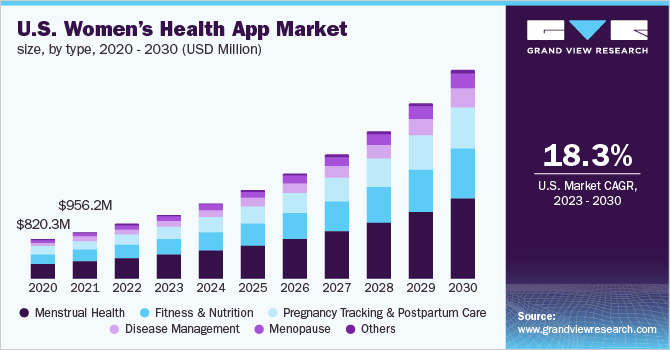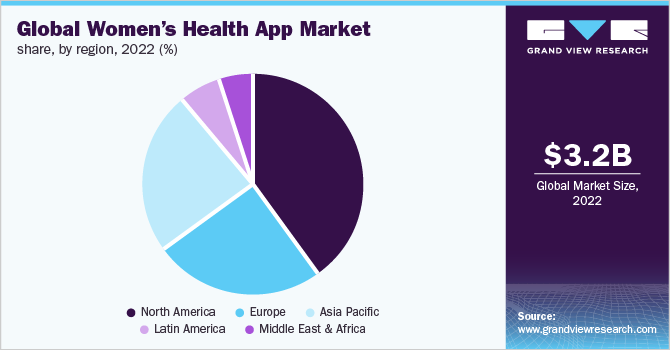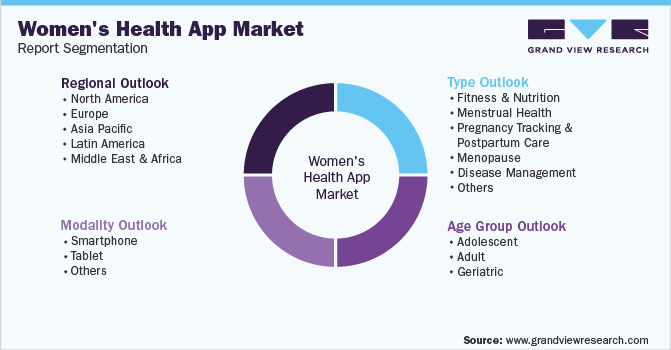- Home
- »
- Healthcare IT
- »
-
Women’s Health App Market Size & Share Report, 2030GVR Report cover
![Women’s Health App Market Size, Share & Trends Report]()
Women’s Health App Market Size, Share & Trends Analysis Report By Type (Menstrual Health, Fitness & Nutrition, Pregnancy Tracking & Postpartum Care), By Modality, By Age Group, By Region (North America, APAC), And Segment Forecasts, 2023 - 2030
- Report ID: GVR-3-68038-970-8
- Number of Report Pages: 83
- Format: PDF, Horizon Databook
- Historical Range: 2016 - 2021
- Forecast Period: 2022 - 2030
- Industry: Healthcare
Report Overview
The global women’s health app market size was valued at USD 3.2 billion in 2022 and is expected to grow at a compound annual growth rate (CAGR) of 19.6% from 2023 to 2030. The increasing incidence of diseases among women and the high penetration of smartphones is expected to drive the market growth. Dietary changes, stress, and alcohol intake are important factors that cause hormonal imbalances in women. Women are vulnerable to several postmenopausal diseases, such as Osteoarthritis (OA), anemia, obesity, irregular menstruation, depression, and fibromyalgia. As the aging population and incidence of obesity increase, the prevalence of OA is expected to increase.

According to the United Nations, about 10 to 15% of adults over the age of 60 have some degree of osteoarthritis, a condition that is common in women. Anemia continues to affect millions of women around the world. According to the WHO, the prevalence of anemia was 29.9% among females of reproductive age, which is equivalent to nearly half a billion females aged 15-49 years. In December 2020, Sanguina, Inc. announced the launch of AnemoCheck Mobile, a smartphone application that determines hemoglobin levels by the color of fingernails. Thus, the rising prevalence of anemia coupled with the launch of disease-specific solutions is expected to fuel the market growth.
The increasing prevalence of arthritis in females is expected to boost the market. Arthritis can be eased by developing healthy habits regularly and changing daily activities. For instance, The Arthritis Foundation recently launched Vim, an application that allows users to control and balance food intake, exercise, sleep, dosing, and mood. The software trackswhich user behavior heightens the pain of arthritis. Such innovations in the healthcare sector are expected to bode well with the market.Furthermore,rising government and private investmentsare contributing to the adoption of software for women’s welfare.
COVID-19 women’s health app market impact: 40.2% increase from 2019 to 2021
Pandemic Impact
Post COVID Outlook
COVID-19 pandemic positively impacted the overall mHealth app industry. During the pandemic, mHealth apps played an important role in mitigating the COVID-19 response. Due to lockdowns and increase focus on health, the demand for fitness apps increased globally
The pandemic is expected to create more self-awareness and self-care among females, especially working-class women. This is expected to increase the user base for fitness tracking apps around the world
The pandemic limited the hospital and physician visits for pregnant women and the ones undergoing fertility treatments. This led to an increase in the use of virtual care and self-care via women’s health apps
Health applications and digital platforms are projected to play a big role in enhancing women’s disease management in the forthcoming years. For instance, in April 2021, Nabla announced the launch of an app focused on feminine health. Such developments are anticipated to bode well for the market
For instance, in May 2021, the Australian government announced an investment of USD 244.3 million over the next 4 years. The investment will be used to support women’s health including funding for breast and cervical cancer, reproductive health, and endometriosis. Increasing funding for startup businesses and the entry of new players are propelling market growth. For instance, in September 2021, the Flo application received USD 50 million in Series B funding, bringing the total capital raised to USD 65 million. The company is planning to use the funding to develop personalized solutions and give users advanced insights related to their menstrual cycle and symptom patterns to aid in proactive management and improvement of their general wellbeing.
Type Insights
Based on type, the menstrual health segment dominated the market in 2022 and accounted for the largest share of more than 37.5% of the overall revenue and is projected to grow at maximum CAGR of 19.9% during the forecast period. This is due to females becoming more aware of the necessity of maintaining hygiene during the menstrual cycles. High adoption of period tracking apps globally, along with the inclusion of innovative products and features by key players is boosting the segment growth. For instance, in June 2019, Apple Inc. added a menstrual cycle tracking software named Cycle Tracker, which is compatible with Apple’s Health App on the upcoming iOS 13 and Watches OS 6 update. The fitness & nutrition segment is poised to have high growth owing to the rising popularity of fitness applications and rising consumer interest in wellness therapies.
The COVID-19 pandemic has raised awareness among individuals, particularly women, about the importance of maintaining fitness levels. Furthermore, the temporary closure of gyms resulted in an increased demand for mobile-based fitness apps. The pregnancy tracking and postpartum care segment are projected to witness significant growth during the forecast period. The increasing use of pregnancy apps to maintain the well-being of both mother and child is fueling the segment growth.For instance, in June 2022, women’s hygiene brand, Sirona launched a menstrual tracker on WhatsApp. The WhatsApp time tracking tool helps users track their period by simply sending “Hello” to Sirona’s WhatsApp business account.
Regional Insights
North America is estimated to account for the largest share of more than 39.00% of the global revenue in 2022. This is due to the increasing adoption of smartphones and rising government interest in reducing healthcare costs. In addition, the high adoption of technologically advanced products and regulatory reforms for approval & usage of mobile-based applications are contributing to the growth of the market in the region. The market in AsiaPacific is expected to grow at a significant rate with a CAGR of 21.0% during the forecast period due to the high number of smartphone users in China and India, increasing internet penetration, and growing demand for effective healthcare technologies.

In addition, increasing government focus on women’s wellness is favoring the market growth. For instance,the Indian government launched Swasthya Samiksha app that enables the members of the parliament to track maternal and reproductive health data and indicators of their respective constituencies. The market in Europe is expected to grow significantly owing to the increasing government investment in IT infrastructure and the growing number of digital startups in the region. Increasing awareness about reproductive health, the rising prevalence of OA, and improving internet access are also propelling the market growth in Europe.
Key Companies & Market Share Insights
The market is highly fragmented with the presence of various software companies. Collaborations for software development, incorporation of the latest technologies, new product launches, and regional expansion in emerging markets are some of the key strategies used by companies to gain a competitive edge. For example, in March 2021, Clue received FDA approval to launch ClueBirth Control, a digital contraceptive that statistically predicts ovulation and is used to prevent pregnancy. Some of the prominent players in the global women’s health app market include:
-
Flo Health, Inc.
-
Clue
-
Glow, Inc.
-
Withings
-
Fitbit, Inc.
-
Natural Cycles
-
Apple Inc.
-
Wildflower Health
-
HelloBaby, Inc.
-
Ovia Health
Women’s Health App Market Report Scope
Report Attribute
Details
The market size value in 2023
USD 3.8 billion
The revenue forecast in 2030
USD 13.2 billion
Growth rate
CAGR of 19.6% from 2023 to 2030
The base year for estimation
2022
Historical data
2016 - 2021
Forecast period
2023 - 2030
Quantitative units
Revenue in USD million/billion and CAGR from 2023 to 2030
Report coverage
Revenue forecast, company ranking, competitive landscape, growth factors, and trends
Segments covered
Type, modality, age group, region
Regional scope
North America; Europe; Asia Pacific; Latin America; Middle East & Africa
Country scope
U.S., Canada, U.K., Germany, France, Italy, Spain, Japan, China, India, Australia, South Korea Brazil, Mexico, Argentina. South Africa, Saudi Arabia, UAE
Key companies profiled
Flo Health, Inc.; Clue; Apple Inc.; Glow, Inc.; Withings; Fitbit, Inc.; Natural Cycles; Wildflower Health; HelloBaby, Inc.; Ovia Health
Customization scope
Free report customization (equivalent to up to 8 analysts working days) with purchase. Addition or alteration to country, regional & segment scope.
Pricing and purchase options
Avail customized purchase options to meet your exact research needs. Explore purchase options
Global Women’s Health App Market Segmentation
This report forecasts revenue growth at global, regional, and country levels and provides an analysis of the latest industry trends in each of the sub-segments from 2016 to 2030. For this study, Grand View Research has segmented the global women’s health app market based on type, modality, age group, and region:

-
Type Outlook (Revenue, USD Million, 2016 - 2030)
-
Fitness & Nutrition
-
Menstrual Health
-
Pregnancy Tracking & Postpartum Care
-
Menopause
-
Disease Management
-
Others
-
-
Modality Outlook (Revenue, USD Million, 2016 - 2030)
-
Smartphone
-
Tablet
-
Others
-
-
Age Group Outlook (Revenue, USD Million, 2016 - 2030)
-
Adolescent
-
Adult
-
Geriatric
-
-
Regional Outlook (Revenue, USD Million, 2016 - 2030)
-
North America
-
U.S.
-
Canada
-
-
Europe
-
U.K.
-
Germany
-
France
-
Italy
-
Spain
-
-
Asia Pacific
-
China
-
Japan
-
India
-
Australia
-
South Korea
-
-
Latin America
-
Brazil
-
Mexico
-
Argentina
-
-
Middle East & Africa
-
South Africa
-
Saudi Arabia
-
UAE
-
-
Frequently Asked Questions About This Report
b. The global women's health app market size was estimated at USD 3.2 billion in 2022 and is expected to reach USD 3.8 billion in 2023.
b. The global women's health app market is expected to grow at a compound annual growth rate of 19.60% from 2023 to 2030 to reach USD 13.2 billion by 2030.
b. North America dominated the women’s health app market and accounted for the largest revenue share of 39.1% in 2022. High adoption of mhealth apps, rising awareness about women's health, and strong government support to reduce healthcare cost are propelling the market growth in the region
b. Some key players operating in the women's health app market are Flo Health, Inc.; Clue; Apple Inc.; Glow, Inc.; Withings; Fitbit, Inc.; Natural Cycles; Wildflower Health; HelloBaby, Inc.; and Ovia Health
b. Key factors that are driving the women's health app market growth include increased mobile phone penetration, changes in dietary habits, and rising stress among the working women population.
b. The menstrual health segment dominated the market for women’s health app and accounted for the largest revenue share owing to the increasing demand for period cycle tracking app and new product launches.
Share this report with your colleague or friend.
![gvr icn]()
NEED A CUSTOM REPORT?
We can customize every report - free of charge - including purchasing stand-alone sections or country-level reports, as well as offer affordable discounts for start-ups & universities. Contact us now
![Certified Icon]()
We are GDPR and CCPA compliant! Your transaction & personal information is safe and secure. For more details, please read our privacy policy.
We are committed towards customer satisfaction, and quality service.
"The quality of research they have done for us has been excellent."





